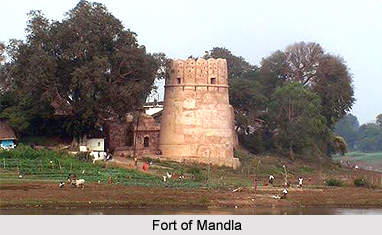 History of Mandla District in Madhya Pradesh states that from 1818 AD to 1835 AD, Mandla was considered a tehsil of Seoni District, whereas Ramgarh (now Dindori tract) and Sohagpur (now in Shahdol District) were included in Jabalpur district. In 1840 A.D. Mandla was also transferred from Seoni to Jabalpur District. It was upgraded to the status of a district in the year 1849 but only six months later is was reverted to its old position. Finally, in 1851, Mandla, Ramgarh and Sohagpur were united to constitute the independent district of Mandla. It was put under the charge of a Deputy Commissioner.
History of Mandla District in Madhya Pradesh states that from 1818 AD to 1835 AD, Mandla was considered a tehsil of Seoni District, whereas Ramgarh (now Dindori tract) and Sohagpur (now in Shahdol District) were included in Jabalpur district. In 1840 A.D. Mandla was also transferred from Seoni to Jabalpur District. It was upgraded to the status of a district in the year 1849 but only six months later is was reverted to its old position. Finally, in 1851, Mandla, Ramgarh and Sohagpur were united to constitute the independent district of Mandla. It was put under the charge of a Deputy Commissioner.
Further, according to the history of Mandla District, at the commencement of the Sepoy mutiny 1857, the chief of Ramgarh(Princely State of Ramgarh), Shahpura and Sohagpur joined the mutineers. When order was restored, Sohagpur was transferred to Rewa District and the estate of Ramgarh and Shahpura were confiscated. In 1858, after some unsuccessful attempts of Mutiny, British administration was firmly established at Mandla District. Moreover, numerous changes were made in the territory of the district. In the year 1867, on the formation of Balaghat district, 262 villages of Ramgarh-Bichhiya were transferred from Seoni District to Mandla. Originally, the district had only two tehsils namely Mandla and Ramgarh.
The present Dindori tract was known as Ramgarh till the year 1904, when it was given its present name. In 1892, the first Indian civil service officer in the state was appointed as the deputy commissioner and was posted at Mandla. In 1914, a third tehsil Niwas was formed with headquarters at the village with the same name. Prior to May, 1998 Mandla District was divided into six tehsils, namely Mandla, Nainpur, Bichhiya, Dindori, Niwas and Shahpura. It was also divided into three sub-divisions for revenue and general administration purposes. Mandla sub-division comprised Bichhiya, Nainpur and Mandla tehsils, while Niwas sub-division had Niwas and Shahpura tehsils. Dindori was the eastern sub-division which had only Dindori tehsil.
With the promulgation of Madhya Pradesh Reorganisation of the District Act, from 21st May 1998, Mandla District has been bifurcated into Mandla and Dindori District. Dindori and Shahpura tehsils and Mahandwani Development Block formed Dindori District while the rest of the area existed in Mandla District.
History of Mandla District also suggests that this region played a great role in the freedom struggle of the country. After the momentous session of Nagpur Congress in December, 1920, the Central Provinces were grouped into three committees, which were later called the Vidarbha provincial Committee, Mahakoshal provincial Committee and the Nagpur provincial Committee. This alignment of province on the linguistic principles had a significant effect on the growth of the Freedom Movement every where including Mandla. The Freedom Movement continued to gain its rhythm in Mandla District as elsewhere.






